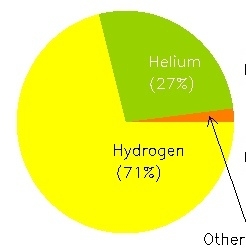
Saturn is predominantly composed of hydrogen and helium, the two basic gases of the universe. The planet also bears traces of ices containing ammonia, methane, and water. Unlike the rocky terrestrial planets, gas giants such as Saturn lack the layered crust-mantle-core structure, because they formed differently from their rocky siblings.
Saturn is classified as a gas giant because it is almost completely made of gas. Its atmosphere bleeds into its “surface” with little distinction. If a spacecraft attempted to touch down on Saturn, it would never find solid ground. Of course, the craft would be fortunate to survive long before the increasing pressure of the planet crushed it.
Because Saturn lacks a traditional ground, scientists consider the surface of the planet to begin when the pressure exceeds one bar, the approximate pressure at sea level on Earth.
At higher pressures, below the determined surface, hydrogen on Saturn becomes liquid. Traveling inward toward the center of the planet, the increased pressure causes the liquefied gas to become metallic hydrogen. Saturn does not have as much metallic hydrogen as the largest planet, Jupiter, but it does contain more ices. Saturn is also significantly less dense than any other planet in the solar system; in a large enough pool of water, the ringed planet would float.
As on Jupiter, the liquid metallic hydrogen drives the magnetic field of Saturn. Saturn’s magnetosphere is smaller than its giant sibling, but still significantly more powerful than those found on the terrestrial planets. With a magnetosphere large enough to contain the entire planet and its rings, Saturn’s magnetic field is 578 times as powerful as Earth’s.
Credit : Space.com
Picture Credit : Google



